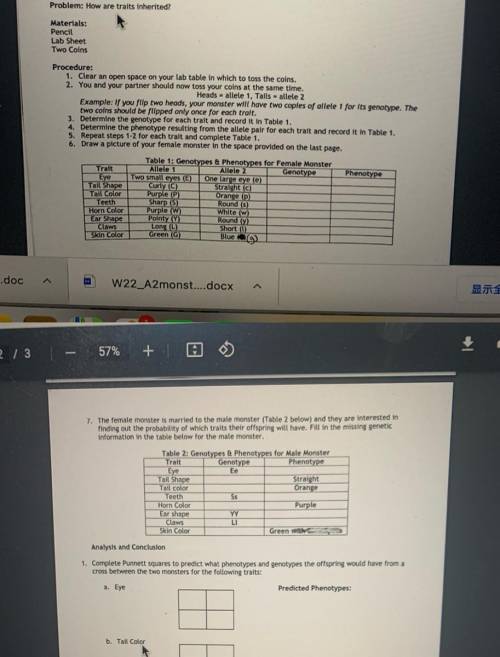Due:
Pre Lab Discussion
Monster Genetics Lab
Heredity is the passing on of traits, or...

Biology, 26.04.2021 20:50 samreitz1147
Due:
Pre Lab Discussion
Monster Genetics Lab
Heredity is the passing on of traits, or characteristics, from parent to offspring. The units of heredity are
called genes. Different versions of the same gene are called alleles. Genes are found on the chromosomes
in a cell. The comdinations of genes for each trait occur by chance.
When one allele in a pair is stronger than the other allele, the trait of the weaker allele is masked, or
hidden. The stronger allele is the dominant allele, and the allele that is masked is the recessive allele.
Dominant alleles are written as capital letters and recessive alleles are written as lowercase letters. If both
alleles are different, the trait is said to be heterozygous, or hybrid. Sometimes alleles are neither dominant
nor recessive. The result of such a situation is a blending of traits.
fse
hes
The genetic makeup of an individual is known as its genotype. The observable physical characteristics of an
individual that are the result of the genotype are known as its phenotype.
In humans, the sex of an individual is determined by the particular combination of the two sex
chromosomes. Individuals that have two X chromosomes (XX) are females, whereas those with an X and a Y
chromosome (XY) are males,
he
5 m
writ
neti
In this investigation, you will work with a partner to observe how the results of different gene combinations
produce certain traits.
Problem: How are traits inherited?
Materials:
Pencil
Lab Sheet


Answers: 3


Another question on Biology

Biology, 21.06.2019 13:00
Which supports the idea that birds and butterflies both have wings but they do not have a common ancestor with wings? the wings are analogous structures that evolved differently and do not have a similar internal structure. the wings are homologous structures that evolved differently and do not have a similar internal structure. wings of birds are vestigial structures, but the wing structures of bats are not vestigial. wings of bats are vestigial structures, but the wing structures of birds are not vestigial.
Answers: 2

Biology, 22.06.2019 02:10
Draw the structure of dna nucleotide with adenine as nitrogenous base
Answers: 3


Biology, 22.06.2019 22:00
Ascientist is examining the role of an element found in facts and carbohydrates of living things. this element makes up 65% of human body mass. which statement describes he is studying
Answers: 3
You know the right answer?
Questions




Mathematics, 19.01.2021 09:40

Biology, 19.01.2021 09:40


Chemistry, 19.01.2021 09:40



Mathematics, 19.01.2021 09:40



English, 19.01.2021 09:40

Mathematics, 19.01.2021 09:40




Mathematics, 19.01.2021 09:40

Mathematics, 19.01.2021 09:40

Geography, 19.01.2021 09:40



